Patrick Shirvington: The Story Behind Can You Find Me?
October 6th, 2017 THE IDEA
While sketching in the bushland near my studio, I suddenly noticed a stick insect on a branch and realised there are so many similar creatures that go unnoticed. Being in the bushland doesn’t always result in us seeing the hidden creatures that live there. With that in mind the
idea was born. So let’s find these animals.
THE PROCESS
The process of making a picture book is usually fairly standard. However in the case of this book “Can You find Me ? “, the procedure was reversed. I collaborated with renowned children’s book author Dr Gordon Winch, who wrote the text to describe the illustrations of the animals I produced. After some discussion with Gordon we decided on which animals to use, giving me the freedom to go ahead and create them. We decided to come up with a variety of animals from different habitats from the land, air and the sea. The difficulty of finding the animals on the pages would increase as we moved through the book.
THE SKETCHES AND FINAL ARTWORK
Being an artist, I tend to produce my work onsite or as it is termed en plein air. I begin with little sketches, getting the feel for the particular landscape, feeling the movement and observing the light. For this purpose I will look at the echidna and gecko, both of which inhabit my immediate surrounds. I was fortunate enough to see the echidna scratching around when I was on a bush walk not far from home, so was able to get a reasonable photograph.
While sketching in the bushland near my studio, I suddenly noticed a stick insect on a branch and realised there are so many similar creatures that go unnoticed. Being in the bushland doesn’t always result in us seeing the hidden creatures that live there. With that in mind the
idea was born. So let’s find these animals.
THE PROCESS
The process of making a picture book is usually fairly standard. However in the case of this book “Can You find Me ? “, the procedure was reversed. I collaborated with renowned children’s book author Dr Gordon Winch, who wrote the text to describe the illustrations of the animals I produced. After some discussion with Gordon we decided on which animals to use, giving me the freedom to go ahead and create them. We decided to come up with a variety of animals from different habitats from the land, air and the sea. The difficulty of finding the animals on the pages would increase as we moved through the book.
THE SKETCHES AND FINAL ARTWORK
Being an artist, I tend to produce my work onsite or as it is termed en plein air. I begin with little sketches, getting the feel for the particular landscape, feeling the movement and observing the light. For this purpose I will look at the echidna and gecko, both of which inhabit my immediate surrounds. I was fortunate enough to see the echidna scratching around when I was on a bush walk not far from home, so was able to get a reasonable photograph.
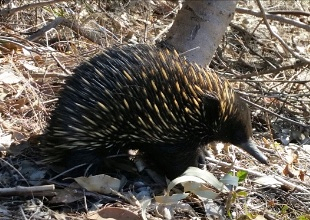
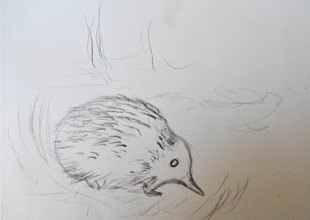
From the photo I then commenced the drawing, using a 2B pencil on watercolour paper. I endeavor to draw the animal, capturing its nature and personality. In the case of the echidna, I noticed it’s funny walk, cuteness and of course; how it blends in with the surrounding landscape. Once I sketch out a basic interpretation, it’s then time to apply the paint. Back in the studio I rough things out and begin to apply the paint limiting my palette to the three
primary colours ie red, yellow and blue. This allows the character to blend in softly becoming a part of its environment.
primary colours ie red, yellow and blue. This allows the character to blend in softly becoming a part of its environment.
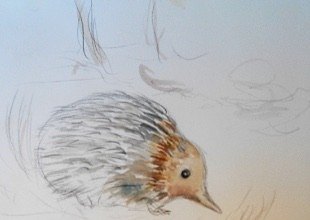
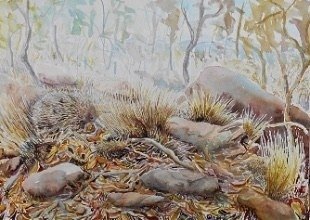
The Gecko is approached the same way, and being a local resident, living in a rock ledge
behind my studio, wasn’t hard to observe his habitat. The thing I really like
about the gecko is the soft texture of the skin as a complement to the surrounding
sandstone and harsh environment. The main thing was to have him blend in to his surrounds, so once again I used similar colours throughout the illustration.
behind my studio, wasn’t hard to observe his habitat. The thing I really like
about the gecko is the soft texture of the skin as a complement to the surrounding
sandstone and harsh environment. The main thing was to have him blend in to his surrounds, so once again I used similar colours throughout the illustration.
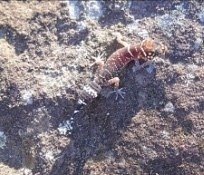
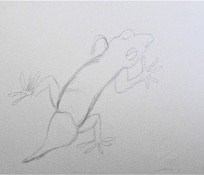
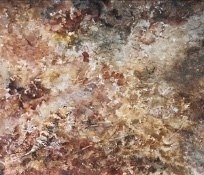
In all of my illustrations I work directly onto the paper, in this case a 300gm A3 Arches watercolour paper, which will be the finished artwork for the book.
All the animals in the book have different personalities and I love playing with these characters with paint on paper to uplift the spirit of not just the children but also mums and dads rekindling their own childhood memories.
All the animals in the book have different personalities and I love playing with these characters with paint on paper to uplift the spirit of not just the children but also mums and dads rekindling their own childhood memories.
Comments (2)
Robin - October 31st, 2017 1:45am
Hi Pat , I am amazed at how canny your sketches are at conveying the nature of the two specimens here..and saw that you will be speaking at CHEN soon..wish I could be there, all the best, Rob
Reply
Hi Pat , I am amazed at how canny your sketches are at conveying the nature of the two specimens here..and saw that you will be speaking at CHEN soon..wish I could be there, all the best, Rob
Reply
Leave A Comment
Thank you for your comments, they will appear shortly once approved.
View by Category
Latest PostsPopular Posts1
Speech Pathology Book of the Year AwardsJuly 26th, 20232
CBCA AwardsJune 12th, 20233
Elisa Paganelli shares how she created the cover art for Odelia and the Varmint!April 30th, 20234
Pirates, Plots, and Victorian London: An Interview with Jenny Moore on Odelia and the VarmintApril 26th, 20235
Get to Know Corinne Fenton, Lionel and Maverick!June 17th, 20221
The Last Anzac - A Letter from Alec Campbell to his MotherApril 1st, 20192
Ellie the Pug - How to Care for a PugApril 8th, 20193
Patrick Shirvington: The Story Behind Can You Find Me?October 6th, 20174
Elisa Paganelli shares how she created the cover art for Odelia and the Varmint!April 30th, 20235
Speech Pathology Book of the Year AwardsJuly 26th, 2023
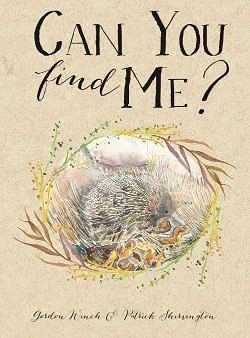
So sweet Pat!
I'm emailing you from our local library where Ijust returned a beautiful book of Arthur Boyd's collection & was again gazing at Bundanon on line and dreaming of places by the sea and envious of all those other over 60's who live near Shoalhaven River. I hope you are well and clearly you are very happy, I have this photograph of my children romping in the ocean on their last holliday together and am hoping one day you might find the time to paint it for me, I really don't know anyone who has your talent exceptpossibly a friend of my sons who lives in Tassie and is too busy paying a mortgage to paint. x Lu
Reply